Gold is a majestic color, often associated with wealth and jewelry pieces. But do you know that they are not the only things that possess the beauty of gold?
The animal world is vast, and various species in this world have varieties of colors to show. Today we are going to talk about some of the most popular golden animals. These animals stand out from others due to their rare color pattern. Let’s learn some fascinating facts regarding them.
25 Most Popular Golden Animals In the World
1) Gee’s Golden Langur
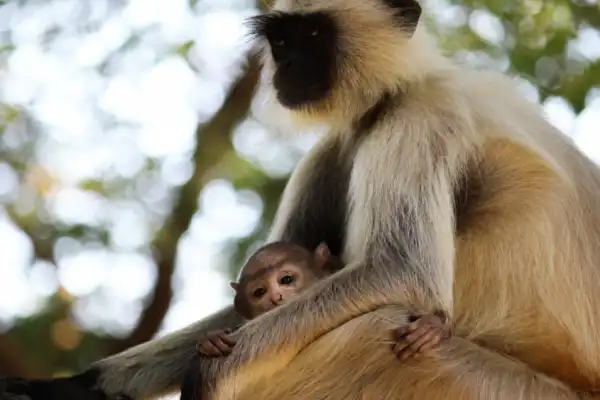
- Scientific Name: Trachypithecus geei
- Habitat: Generally found in forests such as evergreen, deciduous forests, semi-tropical forests, and temperate forests.
These langurs have golden fur covering the entire body, except for the face and base of hands and feet which are black.
The fur color might vary between individuals. The color also changes from season to season, where they have a golden chestnut appearance in winter which changes to creamy white in summer.
The males are larger and have a more robust build than the females. These species are found in parts of Northeastern India and Southern Bhutan. They are pretty shy in nature.
2) Bolivian Golden Bat
- Scientific Name: Myotis midastactus
- Habitat: Generally found in Arid dry climates of Bolivia.
A lot of people have a misconception that bats are vampire-like creatures who drink human blood only! But in reality, they usually prey on small insects and fruits and very rarely, the blood of other animals (vampire bats).
The Bolivian golden bat is not a concern in that case when it comes to what they eat since they prefer insects mostly.
These bats have bright golden fur and small eyes. Their coloration helps them to camouflage in the surrounding desert regions.
These are relatively new species of bats that were discovered in Central America. Their scientific name is based on the legendary Greek myth King Midas.
3) Golden Ghost Crab

- Scientific Name: Ocypode convexa
- Habitat: Found in Open sandy beaches close to their burrows.
Also known as the Western Ghost crab, they are large ghost crab species with a size of 4.5 cm and a box-shaped carapace. These crabs are found in Western Australia.
The term “ghost” basically refers to their nature of suddenly appearing and vanishing on the beach and their long bulging eyestalks.
The body color is golden-yellow and they have two unequal claws, one larger claw which is used for defense and mating, and the other small claw for feeding.
The females usually have two feeding claws. These crabs mainly feed on small animals and carcasses.
4) The Golden Gecko
- Scientific Name: Gekko badenii
- Habitat: Lowland forests and areas with a prevalence of rocky granites.
These geckos have golden-colored scales covering their body. The males are larger with long tails, while females are a bit smaller.
Their geographic range includes the Tay Nih and Kum Tum provinces of Southern Vietnam. These geckos are insectivores and eat wax worms, mealworms, and crickets. Presently, this species is on the IUCN’s list of Critically endangered category.
5) Golden Apple Snail
- Scientific Name: Pomacea canaliculata
- Habitat: Waterbodies such as swamps, ponds, and freshwater lakes.
These amphibious snails have great adaptability to various environmental conditions or habitats. The shell is muddy brown or golden-brown and the flesh color is yellowish-golden.
These snails are a major pest species of crops, especially Rice plants. Since they are edible, they were introduced in Asian countries as food and also pet species.
However, due to their rapid growth, they became a major nuisance for the agricultural economy.
Their eggs are small and pinkish and appear in clusters, which remain attached to the growing vegetation crops.
6) American Goldfinch
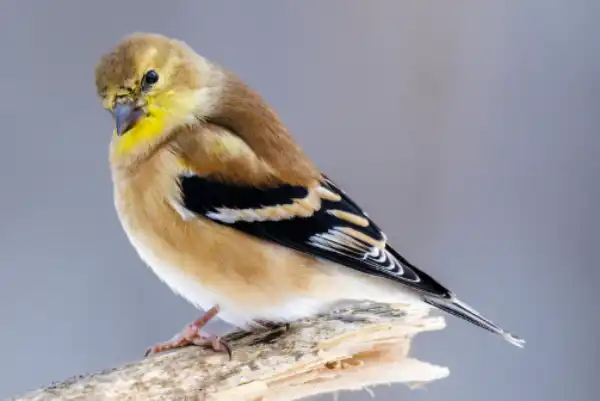
- Scientific Name: Spinus tristis
- Habitat: Wide distribution such as forests, fields, grasslands, Shrublands
These beautiful birds show a variety of colors, particularly the males in summer have bright yellow body feathers with black wings and tails, interspersed with white. The forehead has black feathers which contrasts with the yellow.
Found in Northern states of America such as Washington and New Jersey, these birds have beautiful singing voices and their diet is strictly plant-based such as seeds, and fruits.
7) Golden Poison Frog

- Scientific Name: Phyllobates terribilis
- Habitat: Forests and on the ground near rivers.
What makes these frog species popular in the animal world? Well as their name suggests, they are extremely poisonous.
They are so poisonous that even touching them bare-handed is very harmful. A small amount of their poison can kill almost 10 people on average. The terrible name indeed suits them!
Their body is golden yellow, which can sometimes have black spots on the legs and snout. In some frogs, the body color can be orange or orange-yellow.
The indigenous people of Columbia refer to them as Choco and use the poison from the frog’s body by impaling them or rubbing them on their arrows or darts.
8) Golden Lion Tamarin
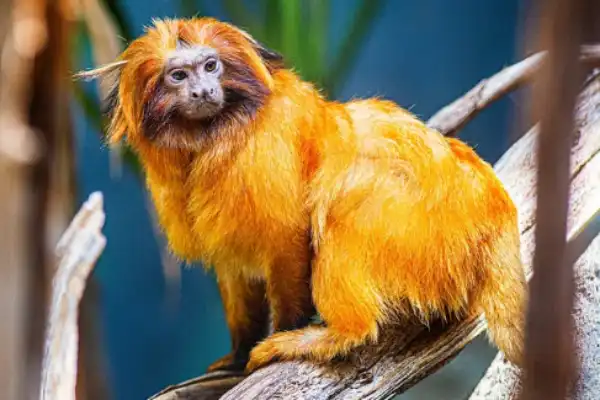
- Scientific Name: Leontopithecus rosalia
- Habitat: Tropical Rain forests.
Members of this social species have golden yellow fur color with a prominent mane shape around the head and ears due to long hairs, which is the main reason they are called Lion tamarins. The face is naked and pale black.
They are omnivores, they usually feed on almost all plant material, insects, and sometimes small animals.
These monkeys have a special way of defending themselves from predators such that they will change their resting dens frequently so that predators can not catch their scent easily. Currently, this species is on the endangered list.
9) Chinese Golden Pheasant
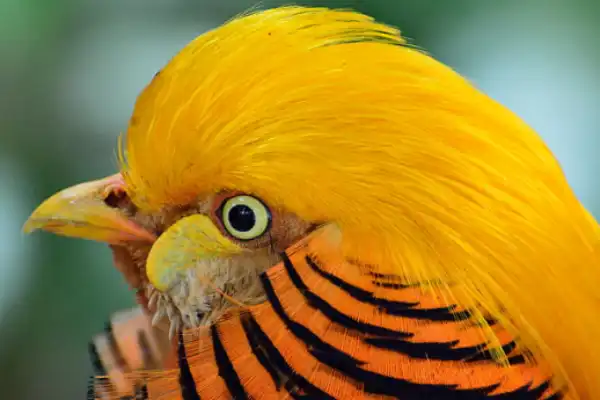
- Scientific Name: Chrysolophus pictus
- Habitat: Dense forests, and bushes of Western China.
In most of the bird species, it is the males who are more colorful than the females. The male pheasants have bright color patterns, with a golden crest on top of the head, extending to the neck.
The bright red body and the upper back are green or sometimes blue, meanwhile, the wings are darker, and the tail is pale brown.
To avoid detection, these colorful birds hide in dense and dark forests and at night rest at a considerable height from the ground in trees.
To sight such wonderful birds, it is advised to check in early morning. These birds make a unique “Chack Chack” type of sound. Apart from China, they are distributed in the United Kingdom, Australia, and New Zealand as well.
10) Panamanian Golden Frog
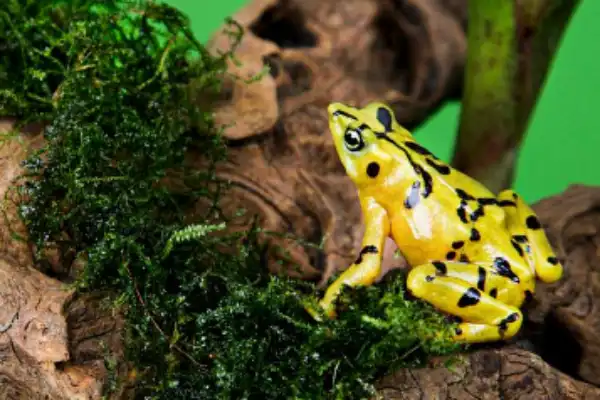
- Scientific Name: Atelopus zeteki
- Habitat: Generally favors streams of wet forests and dry forests.
These beautiful-looking frogs have the honor of being the National Symbol of Panama. The body is entirely golden-yellow, with black X-markings on the back and blotches or spots on the limbs. The males are females are indistinguishable due to the same coloration.
Like most colorful frogs, these are also very toxic and their toxic glands produce a unique toxin called Zetekitoxin.
Unlike making mating sounds like other frogs do, these frogs have adapted to visual displays of courtship such as leg and head twitching, and jumping to impress their female counterparts. They often wave their hands too.
11) Yellow Tang Fish
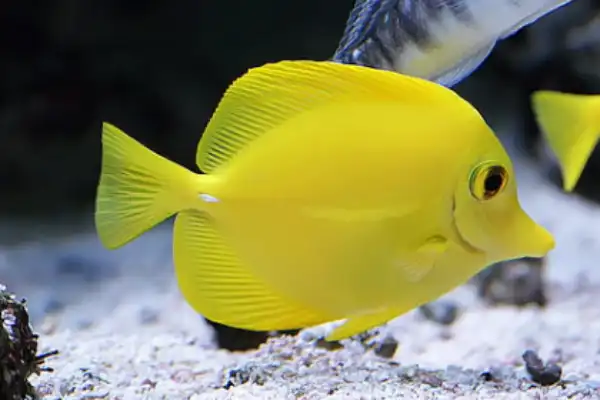
- Scientific Name: Zebrasoma flavescens
- Habitat: Tropical Shallow reefs of the Pacific Ocean, on the west coasts of Hawaiian islands.
They are very popular aquarium fishes which possess a very bright golden-yellow color. The body is flattened and 8 inches in length and around 1 inch in thickness. The mouth is long, and snout-like in appearance.
The males are generally larger than the females in this species. You would be surprised to know that have a “Nocturnal Color” pattern because at night they change their color from golden-yellow to dark-yellow with white lateral stripes.
12) Akhal-Teke Horse
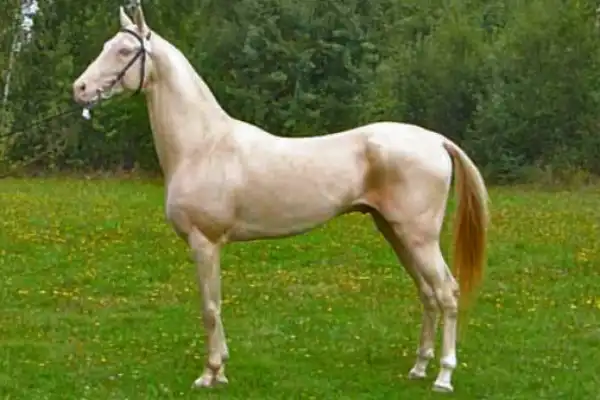
- Scientific Name: Equus ferus caballus
- Habitat: Originally used to reside in the Karakum desert region of Turkmenistan.
These horses are one of the rarest and most elegant breeds in the world. Their coat color shines golden with a glossy metallic sheen in sunlight. They have a well-built body and a size of around 56 to 64 inches.
They are named after the nomadic Teke tribes of Turkmenistan who lived near the Akhal Oasis of the mountains. These horses are popular for their stamina, agility, and speed.
They are used for various purposes such as Sports horses, Show horses, transportation purposes, Showjumping, or dressage horses.
13) Golden Parakeet

- Scientific Name: Guaruba guarouba
- Habitat: Grasslands and Rainforests of the Amazonian region of Brazil.
These birds harbor a variety of colors. The body is covered with bright golden-yellow plumage, whereas the outer wings are green, and long gold-yellow tail wings on the underside. The beak is grayish and their eye rings are pinkish.
They are medium-sized birds, around 34-36 centimeters. They have strong social behavior and prefer to live together in groups and feed on various fruits, seeds, and flowers.
Unfortunately due to the heavy amount of deforestation and hunting, they are severely decreasing in number and are under the Vulnerable category of the IUCN red list.
14) Gold Tegu Lizard
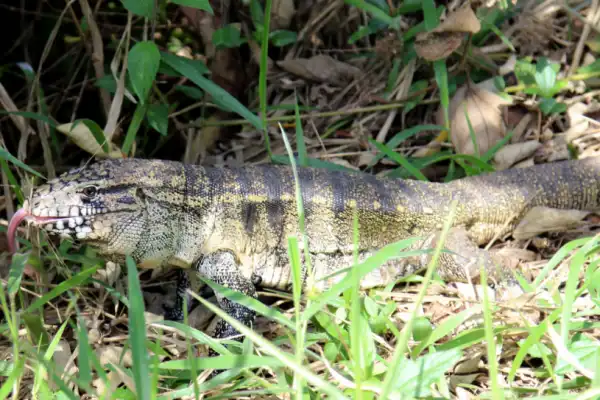
- Scientific Name: Tupinambis teguixin
- Habitat: Tropical rain forests of South America as well as Panama.
Their body is covered with black and golden bands, which are distributed in an alternating fashion. They have powerful limbs and their tail is also very thick. They can grow up to 36 inches.
These reptiles have sharp and dagger-shaped teeth and sharp claws which they often use to capture their prey. Their strong tail also works as a “Whip” to away predators.
Usually, they reside in burrows which they dig themselves and love to bathe in warm sunlight. These lizards are good runners also.
15) Asian Golden Weaver
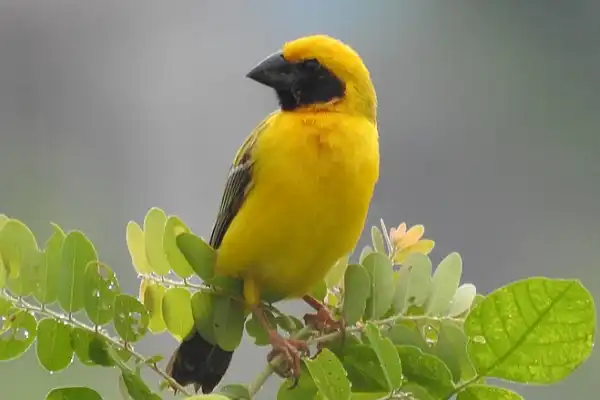
- Scientific Name: Ploceus hypoxanthus
- Habitat: Tropical wetlands, Forests, grasslands.
Found in Cambodia, Thailand, Myanmar, Vietnam, and many other places, these medium-sized finches are currently decreasing in number due to habitat loss by human activities.
They have been assigned the “Critically endangered”species category in the IUCN Red List.
The males, particularly the breeding ones are very colorful and have a golden-yellow body with black upperparts. The beak is also deep black and the face has a black mask-like pattern.
16) Golden Eagle
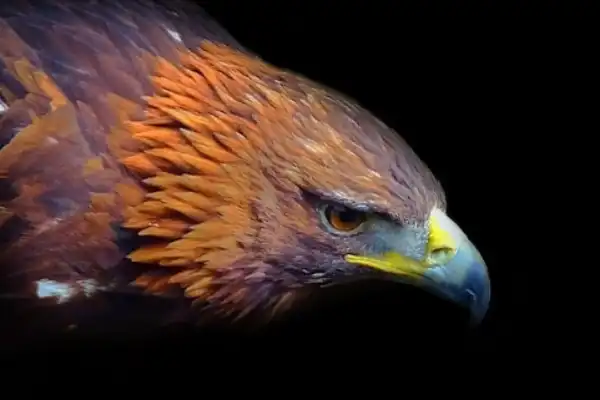
- Scientific Name: Aquila chrysaetos
- Habitat: Found in a wide variety of areas such as shrublands, open grasslands, coniferous forests, and farmlands.
Eagles are probably one of the most handsome birds out there in nature. They have a well-built body, strong and large talons, sharp vision, and are very agile birds. Such qualities make them an efficient predator species.
Their body is covered with dark-brown plumage, with golden color on the back of the head and neck. Tail wings are white with black tips. They spread their wings in a “V” shaped posture and the tips of the wings extend like long fingers.
17) Golden Jackal

- Scientific Name: Canis aureus
- Habitat: Savannas, dry climatic regions, and grasslands.
They have long, pointed nose and ears. Their coat color can vary from season to season, but usually, it is pale golden-yellow with brow tipped. The fur coat is not very long.
These jackals majorly live as a Mating pair and they are monogamous. The additional male non-breeders are known as “Helpers” and they primarily help their parents take care of their next litter.
Golden Jackals hunt in packs because it increases their chances of capturing prey than single hunters. They live in areas adjacent to human habitations and live in rock crevices, burrows, or caverns. When encountering jackals of another pack, they show aggressiveness or use warning howls to warn their own pack.
18) Golden Fruit Dove
- Scientific Name: Ptilinopus luteovirens
- Habitat: Rain forests, open forests, Wetland forests, or sometimes adjacent to human habitations.
This species of dove is quite rare and is endemic to the western Fijii islands such as Viti Levu, Beqa, Gau, and Waya. Usually, doves or pigeons have been seen in grey or white colors, but the golden doves are an exception because the bodies of the males are covered in bright golden yellow plumage.
Apart from the color, another feature that separates them from other doves is their special chest feathers which appear like a mane from a distance. Legs and eye-rings are green. The females have a full dark green plumage.
Also known as the Yellow dove, these bird species are currently under the Threatened species category of the IUCN Red List.
19) Golden Takin
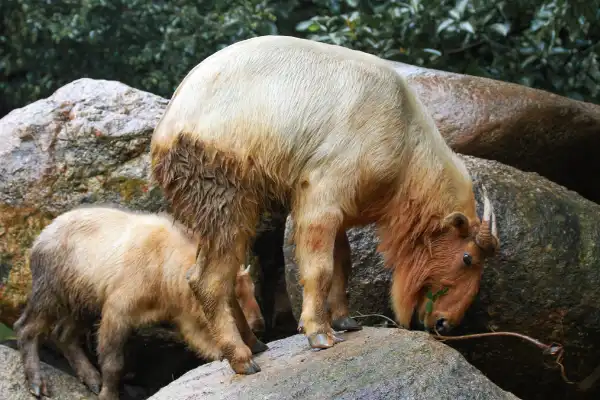
- Scientific Name: Budorcas taxicolor bedfordi
- Habitat: Temperate coniferous forests, mixed forests, or broadleaf forests.
Located in the Shaanxi province of China, these animals have a golden-yellow to creamy-whitish fur color. The males often have gold color in the back of the neck and chest front area. They have backward-pointing horns and small ears. These horns, along with the hooves and nose are black.
These takins live as a group and the number of members of each group varies from seasonal change.
They have developed a special type of warning sound which sounds like a loud Cough like. Such sound warns the other herd members so they can hide themselves. They are also known as Goat antelope.
20) Golden Eyelash Viper
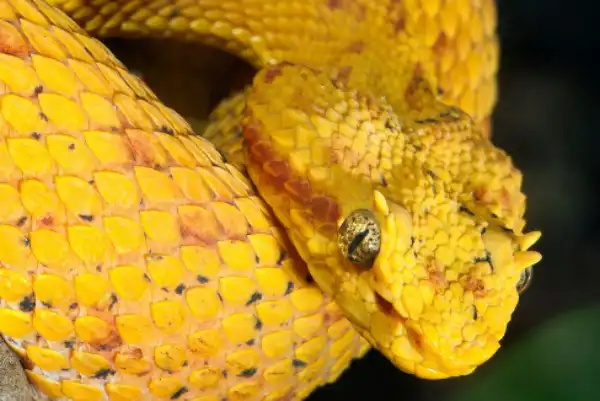
- Scientific Name: Bothriechis schlegelii
- Habitat: Trees, shrubs of tropical moist forests, wet forests.
When talking about varieties of animals, how can we forget about snakes? These beautiful-looking vipers have scales around their eyes that resemble eyelashes. The head is triangular shaped and the pupils are vertical.
These vipers have a golden-yellow slightly raised scales covering their body. The eyelashes help them to remain hidden in foliage. Although venomous, they rarely fight and are not very aggressive.
21) Chinese golden scorpion
- Scientific Name:Mesobuthus martensii
- Habitat: Generally found in dry, warm areas with less vegetation, and sandy habitats.
These tiny scorpions are found in Manchuria, Korea, Mongolia, and China. The back of the body is blackish-grey whereas the legs and tail have a golden-brown hue.
These tiny scorpions are venomous but in reality, instead of harming humans, it has been widely researched because of their medicinal properties. Scientists have purified the venom to extract important proteins to treat various neurological conditions, epilepsy, paralysis, and Alzheimer’s disease.
It is also used as a delicacy in these countries.
22) Armadillo Lizard
- Scientific Name: Ouroborus cataphractus
- Habitat: Usually found in rocky outcrops, caverns, and crevices.
These lizards have spiny elongated scales which give a rock-like appearance. The color has a lot of varieties, the common one being brownish-golden. Their belly and chin are yellow with dark-brown markings.
Endemic to South Africa, these lizards roll themselves and bite their tail to protect their soft belly. Due to this, their shape looks like the ancient symbol ‘Ouroboros”.
23) The Golden Salamander
- Scientific Name: Bolitoglossa jackson
- Habitat: Found in tropical and subtropical forests of Guatemala.
This is an extremely rare species to be seen. Their body is golden-yellow, with a chocolate-brown dorsal band, and the edges of the band are white-lined.
The head is wide and the feet are flat. It was observed almost 42 years later in the year 2017, then in March 2020.
24) Asian golden cat
- Scientific Name: Catopuma temminckii
- Habitat: Tropical and subtropical evergreen forests, rainforests, and open rocky areas.
These cats are declining in number due to poaching hunting and habitat loss. They are medium-sized mammals with multiple color morphs, such as golden-brown or reddish-brown. They have a buffy build body.
In Myanmar and Thailand, villagers refer to them as “Fire-cats” and they believe that the hair from these animals will provide them protection, especially from tigers.
25) De Winton’s golden mole
- Scientific Name: Cryptochloris wintoni
- Habitat: Sandy shores, dry subtropical shrublands.
Would you believe that these species were re-discovered after 86 years? These moles are practically blind but can swim through the sands. Their coats shimmer brightly in the sunlight, hence the name.
The fur is very dense and a yellowish tinge can be seen in their cheek and facial region. Unfortunately, these adorable animals are in the “Critically endangered” category.
Conclusion
Legend says, King Midas turned everything gold whatever he touched. Perhaps these popular golden animals are living proof of that myth!
Also Read:
Hi everyone. I am Sagnik. Biology has always fascinated me since my school days and that interest motivated me to pursue a Bachelor’s degree in Zoology and a Master’s degree in Biotechnology. I learned a lot of new interesting facts and information regarding the biological world we are part of. After obtaining my degree, I started working as a biology teacher through which I am able to teach students the various concepts that I have learned. Apart from my love for this subject, my passion lies in music, and I teach guitar as well. Photography, Reading comics, Drawing, and video editing are some of my other hobbies. I welcome you to a journey with me, where I will share my knowledge and excitement for the living world through my writings with you all.

